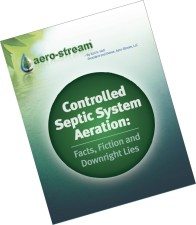There are two answers to the question of “Do septic aerators stir up solids in a septic tank”?, no and yes. The answer is “no” if controlled aeration is applied. The answer is “yes” if a poorly designed septic aerator is installed.
This question has been asked many times over the past 12 years mainly by septic pumpers and septic system installers.
As the internet is now a go to resource for the average consumer looking for information we now get asked more and more by the average homeowner. More recently the question arose through a forum of homeowners. Unfortunately a homeowner purchased what was touted as a “septic aerator” when in fact the aeration unit was designed for pond aeration. This lead the homeowner to believe that aeration stirs up solids and thus a forum was started to inform other homeowners of his dilemma. While I commend the effort of the forum, sometimes consumers have limited knowledge and much of the information is opinion and not vetted fact. Consumer forums are great; however, they should not be the sole source of information. Consumers should look for peer reviews of a product and company.
When a product does not work as described consumers quickly spread the word. An example of this is the forum which found an inferior product. The opposite example is Aero-Stream® which is celebrating over 12 years of being in business. We have earned over 160 five star 3rd party peer reviews.
So what is controlled aeration?
Controlled aeration is a patented process developed by Aero-Stream, LLC. Through the sound application of fluid dynamic engineering principles, a proprietary array of components have been designed to work jointly to provide the specific environment to convert any existing system including a standard single chamber septic tank into an aerobic treatment plant. The combination of many parameters such as air flow rate, diffuser design, diffuser location and the Bio—Brush™ have enabled Aero-Stream® to deploy the technology in thousands upon thousands of applications across North America and around the world.
When controlled aeration is implemented into a single chamber septic tank the total suspended solids are reduced by 60% or more. This is documented using an ANSI/NSF 40 testing protocol. The testing for the case study results listed below was performed at an independent ANSI/NSF certified field testing facility, the Massachusetts Alternative Septic Systems Test Center (MASST) in Barnstable County, MA.
Case Study 1 – Controlled Septic Aerator™ in Single Chamber 1,000 Gallon Septic Tank
NSF 40 Testing Protocol, Single Chamber 1,000 Gallon Septic Tank, 450 GPD
Aero-Stream Remediator® septic aerator was installed in a 1,000 gallon single chamber septic tank at the NSF/ANSI certified Massachusetts Alternative Septic Systems Test Center (MASST) in Barnstable County, MA. Residential strength wastewater was diverted to the test tank at a daily flow rate of 450 gallons per day (GPD), 7 days per week following the NSF/ANSI 40 flow distribution protocol. Data was collected over a 5 week period. The flow rate of 450 GPD is equal to a 3 bedroom home with 6 occupants, each occupant using on average 50 GPD (300 GPD total) with a designed 50% increase in flow rate factor or safety of 75 GPD per occupant (450 GPD total).
Summary: The project yielded a 80% reduction in BOD5 and a 60% reduction in TSS. Contrary to what you may read or heard from your pumper or contractor, controlled septic aeration by Aero-Stream® significantly reduces the effluent strength and significantly reduces solids flowing to the drain field. Some companies recklessly sell septic aerators that are of poor design and have not been tested. They rely on you the homeowner to “test” and even develop their products! This unethical behavior has lead to negative forums with the moderator lumping all septic aerator designs together. These careless accusations are absolutely false. Aero-Stream’s Controlled Septic Aeration™ is proven worldwide and documented in these case studies.
| Sample Date | CBOD5 (mg/l) | TSS (mg/l) |
| 3/15/2012 | 18 | 19 |
| 3/21/2012 | 31 | 29 |
| 3/30/2012 | 31 | 32 |
| 4/06/2012 | 44 | 75 |
| 4/12/2012 | 32 | 49 |
| Average After Aero-Stream Installed | 43 | 61 |
| Average of Standard Anaerobic Septic Tank Effluent | 220 | 150 |
| Reduction | 80% | 60% |
All testing was done by Barnstable County Health Laboratory (M-MA009)
*Method SM5210B 19th ed
**Method SM2540D 20th ed
What Makes a Septic Aerator Inferior?
Beware of any septic tank aerators that have not been tested by an independent facility. There are companies that sell systems with claims of superior oxygen transfer through the use of a synergistic airlift principle. This design is intended to be used in the aeration of ponds. A condition known as stratification in ponds allows the formation of muck on the bottom. In a stagnant pond, the dissolved oxygen is highest at the surface of the water and diminishes to zero dissolved oxygen at the bottom. The muck is partially digested organic material e.g. leaves, dead plants, fecal material that is being slowly broken down by the slow-acting anaerobic bacteria in the water that survive at the bottom. To eliminate the formation of muck there is a need to increase the dissolved oxygen at the bottom so the active aerobic bacteria can digest the organic material swiftly. This design is very good at eliminating the stratification layers in the pond.
Functionally, as the air bubbles rise to the surface they push and pull water with them to create an upward flow of water. This phenomenon is similar to the wind felt by a passing car as you are standing roadside. The car is the air bubble and the wind is the water. The car is actually pushing the air forward and sideways as it passes through it creating the wind.
A diffuser assembly with four horizontal stones creates an airlift column of about 9 inches in diameter or about 64 square inches. A single vertical diffuser creates an airlift column of about 2 inches in diameter or about 3 square inches. The result is that four horizontal stones create over 20 times the amount of circulation in the tank. This is similar to the difference of the wind created by a semi-truck versus a small sub compact car passing by as you are standing roadside!
In a septic tank, too much airlift in the tank creates substantial flow causing the solids to be swept off the tank bottom into the bubble path. These solids stay in suspension and cause the grief as described by the forum.
Any large (greater than 2 inches) diameter diffuser that is very near the bottom of the tank suffers from this airlift principle.
The science of converting a septic tank into an aerobic treatment plant should not be left to a novice. Aero-Stream® has the expertise and knowledge to ensure your system works as required. Feel free to call us at 1-877-254-7093 to explain your septic system problems. We have the solution!













